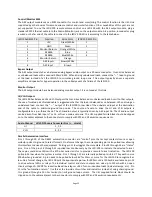
Page 53
Control/Monitor RJ45
The AES output module uses an RJ45 connector for control and monitoring. The control function is the USL-Link
supported by other boards for remote volume control and similar functions. Other capabilities of this port are not
yet supported. To use the JSDV-100 remote volume control on a JSD-100 with the AES output module, plug a
standard CAT5 Ethernet cable into the Control/Monitor jack on the output module. A 6 position, 6 conductor plug
is wired on the far end of the cable to connect to the JSDV-100. Wire it according to the table below.
JSD-100xD RJ45 Pin
Function
Wire Color
JSDV-100 RJ25 Pin
1
+5V
Green/White
1
2
GND
Green
2
3
Monitor Orange/White
4
RS485A
Blue
3
5
RS485B
Blue/White
4
6
Monitor Return -
Orange
7
AES Input+
Brown/White
8
AES Input -
Brown
Bypass Output
The AES output module has a balanced analog bypass audio output on a Phoenix connector. It can drive balanced
or unbalanced loads with a nominal 300mV RMS. When driving unbalanced loads, connect the “– “ lead to ground
at the load instead of at the JSD-100 to minimize ground loop noise. This output typically drives a separate
amplifier and speaker for bypass operation in the unlikely event of a failure of the JSD-100.
Monitor Output
The AES output module has a balanced analog monitor output. It is not used at this time.
HI/VI-N Outputs
The JSD-100 has balanced HI and VI-N outputs that can drive balanced or unbalanced loads. As with other outputs,
the use of twisted pair shielded cable is suggested whether the load is balanced or unbalanced. When driving an
unbalanced load, connect the “ – ” output of the JSD-100 to low side of the unbalanced input at the destination
end of the cable to minimize ground loop noise. The source of audio to drive the HI and VI-N outputs is
configurable on a per-format basis. The VI-N audio output is typically driven by AES input 16. The HI audio output
can be driven from AES inputs 7 or 15, or from a main audio mix. The USL supplied ferrite block should be clipped
on to the cables adjacent to the connectors to comply with FCC and CE emission requirements.
Audio Channel HI/VI-N Phoenix Connector Pins (+, -, shield)
HI
1, 2, 3
VI-N
4, 5, 3
Parallel Automation Interface
Pins 1 through 10 of the DB25F automation connector are “control” pins that accept contact closure or open
collector pulses to ground to select formats. On a format change, the corresponding pin is also pulsed low allowing
this interface to drive other equipment. Pulsing pin 11 low toggles the mute state. Pins 14 through 24 are “status”
pins. One of the pins 14 through 23 is pulled low continuously by the JSD-100 to indicate the selected format.
These pins could drive LEDs with a 470 ohm series resistor to provide a remote format indication. The JSD-100
pulls pin 24 low when the system is muted. Pins 1 through 11 are internally pulled up to +8.4V. They each source
400uA when grounded. A pin needs to be pulled below 2.6V for 10ms or more for the JSD-100 to recognize it as
low. On a format change, the JSD-100 pulls the appropriate pin low for 500ms. +5V at 100mA is available on pin 13
to drive external LEDs or relays. The individual control and status outputs can sink up to 150mA with an open
circuit voltage of +12VDC for inductive loads like relays or +24V for non-inductive loads (indicator lamps, etc.). Pin
12 is the “automation return.” Use this as the low side of switches and indicators instead of using chassis ground.
It is ground through a 10 ohm resistor to limit ground loop current. The USL supplied ferrite block should be
clipped on to the cables adjacent to the connectors to comply with FCC and CE emission requirements.
















































